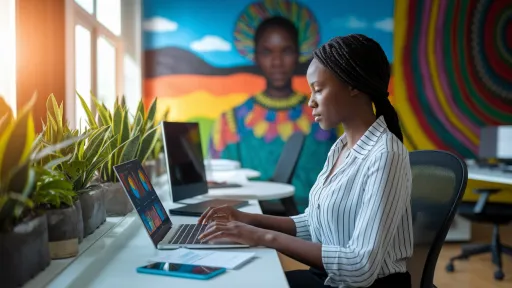
Education is Africa’s ticket to a thriving future, but it’s a tough road—overcrowded classrooms, scarce resources, and language barriers hold millions back. Enter Artificial Intelligence (AI) and Machine Learning (ML), technologies that think and learn like humans, promising to transform how Africa educates its youth. With a median age of 19 and surging mobile use, the continent is primed to harness AI and ML for smarter, more inclusive learning. Here’s how these tools are reshaping African education in 2025—and why it’s a game-changer.
AI and ML: The New Classroom Assistants
AI and ML analyze data, spot patterns, and adapt in real time, making them perfect allies for education. In Africa, where 60% of the population is under 25 (UN, 2024), these technologies can personalize learning, bridge gaps, and train a workforce for tomorrow. The potential is huge: AI could boost Africa’s economy by $1.2 trillion by 2030 (McKinsey), with education playing a key role by unlocking human capital.
Opportunities in African Education
1. Personalized Learning for Every Student
No two learners are alike, but Africa’s overstretched schools often can’t cater to individual needs. ML changes that by tailoring lessons to each student’s pace and style. In Nigeria, uLesson uses AI to deliver interactive video lessons via mobile devices, adapting content based on quiz results. For a continent where 40 million kids are out of school (UNESCO), personalized AI tools can reach remote learners, making education flexible and effective.
2. Breaking Language Barriers
Africa’s 2,000+ languages are a cultural treasure but an educational hurdle. AI-powered translation turns this challenge into an opportunity. Tools like Google Translate’s ML models now handle Swahili, Hausa, and Amharic, while startups like Ghana’s EdAI are building apps to convert lessons into local dialects. This means a child in rural Senegal can learn science in Wolof, not just French, opening doors to millions.
3. Teacher Support and Automation
Teachers in Africa often juggle 60+ students per class (World Bank). AI lightens the load by grading assignments, tracking progress, and flagging struggling learners. In Kenya, M-Shule uses ML to send SMS-based lessons and auto-grade responses, freeing teachers for one-on-one time.
“AI doesn’t replace teachers—it empowers them to focus on what matters: inspiring students,” says Audrey Cheng, founder of M-Shule.
This tech could help retain educators in a system losing talent to burnout.
4. Building AI Skills for the Future
Africa needs its own tech innovators, and education is the starting line. Programs like the African Masters of Machine Intelligence (AMMI) in Kigali train students in AI and ML, creating a talent pool to solve local problems. In South Africa, the University of Pretoria’s AI Hub offers courses blending theory with real-world applications, like predicting crop yields. By teaching AI, Africa grows its own experts—key to competing globally.
5. Affordable EdTech for All
Cost is a barrier, but AI and ML thrive on Africa’s mobile boom—48% penetration and counting (GSMA, 2024). Low-bandwidth apps deliver lessons cheaply, like Eneza Education’s platform in Ghana, Kenya, and Côte d’Ivoire, serving 6 million users with bite-sized, AI-driven content. Pair this with falling smartphone prices, and education becomes a tap away, even in rural areas.
Why Education Matters for Africa’s AI Revolution
Education isn’t just a beneficiary—it’s a driver. A skilled youth can power AI growth across sectors, from agriculture to healthcare. East Africa’s 5.7% economic rise (NatLawReview, 2025) ties to tech hubs like Nairobi, where educated innovators thrive. By 2030, AI-skilled graduates could fuel new jobs—think app developers, data scientists—adding billions to GDP (AUDA-NEPAD).
African Innovators in EdTech
Africa’s leading the charge with homegrown solutions. Nigeria’s uLesson, backed by $15 million in funding (2022), scales AI learning across West Africa. Kenya’s Eneza Education uses ML to refine its SMS platform, reaching even feature-phone users. In Rwanda, the government’s Smart Classroom initiative integrates AI tools into schools, aiming for nationwide coverage by 2030. These pioneers prove Africa can innovate, not just adopt.
Challenges to Tackle
The promise is real, but hurdles remain. Only 40% of Africans have internet (ITU, 2024), and power cuts disrupt digital classrooms. Just half of countries teach computer skills in schools (AUDA-NEPAD), leaving a skills gap. Funding’s thin—EdTech gets a fraction of Africa’s 2.5% global AI market share (Capacity Media, 2024). Solutions? Solar-powered tech, offline AI apps, and programs like AI4D Africa Scholarships, training PhD students in ML (2025 cohort).
2025: A Turning Point
This year, Africa’s education story gets smarter. The African Union’s AI Strategy pushes digital learning, while mobile-first tools fit the continent’s leapfrogging style—skipping outdated systems for cutting-edge ones. With global eyes on Africa’s potential, 2025 could see classrooms transform into hubs of opportunity, powered by AI and ML.
Seizing the Moment
AI and ML can make African education inclusive, affordable, and future-ready. Governments must fund connectivity and skills. Schools should pilot AI tools. And communities can demand learning that works for them. The reward? A generation equipped to lead Africa forward.
Join the Learning Revolution
How could AI transform education in your community? Dive into our resources, share your thoughts below, or connect with us—we’re excited to spark this change together!